What is a Kukri?
TLDR: A kukri is a traditional Nepalese knife with a distinct curved blade, used as both a tool and weapon, famously associated with the Gurkhas.
When it comes to iconic blades, few can match the distinctive curve and rich history of the kukri. I’ve always been fascinated by this versatile tool-cum-weapon, which has been an integral part of Nepalese culture for centuries. The kukri isn’t just another knife; it’s a symbol of pride, a trusted companion in daily life, and a fearsome implement in battle.
As someone who’s handled many blades over the years, I can tell you that the kukri stands out. Its forward-curving blade catches the eye immediately, but there’s so much more to this knife than its unique shape. From its origins in the hills of Nepal to its fame as the signature weapon of the Gurkha soldiers, the kukri has a story that’s as rich and complex as the steel it’s forged from.
In this article, we’ll dive into what makes the kukri special. We’ll explore its history, examine its physical characteristics, and look at how it’s used both traditionally and in modern times. Whether you’re a blade enthusiast, a history buff, or just curious about this remarkable tool, there’s plenty to discover about the kukri.
Origins and History of the Kukri
The kukri’s story is as old as the hills of Nepal, and I’ve always found its history fascinating. This blade has been a part of Nepalese culture for so long that pinpointing its exact origins is tricky. Some say it dates back to the ancient Malla dynasty, around the 7th century. Others argue it might be even older.
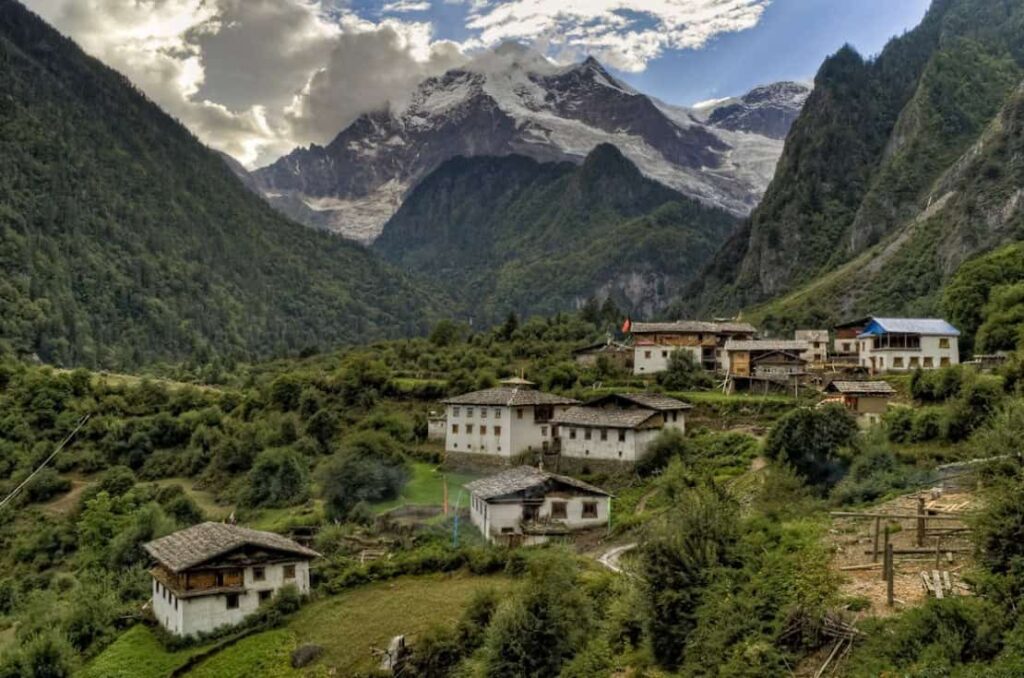
We know that by the time European travelers started writing about Nepal in the 18th century, the kukri was already deeply ingrained in Nepalese society. What really put the kukri on the world map, though, was its connection to the Gurkha soldiers. These fierce Nepalese warriors first caught the attention of the British East India Company during the Anglo-Nepalese War of 1814-1816.
The British were so impressed by the Gurkhas’ fighting prowess and their curved knives that they began recruiting them into their own ranks. From that point on, the kukri became synonymous with Gurkha bravery and skill.
Over time, the kukri has evolved, but not as much as you might think. I’ve seen kukris from different periods, and while there are variations in size and decoration, the basic form has remained remarkably consistent. That’s a testament to its excellent design. Modern kukris might use different steels or synthetic handle materials, but they still maintain that iconic forward curve that makes them instantly recognizable.
One interesting change I’ve noticed is in how the kukri is perceived. Once primarily a tool and weapon of the Nepalese people, it’s now gained international recognition. Knife enthusiasts, collectors, and even survivalists around the world have come to appreciate the kukri’s versatility and unique design. It’s a great example of how a traditional blade can find new life and appreciation in the modern world.
Physical Characteristics of the Kukri
The first thing you’ll notice about a kukri is its distinctive curved blade. It’s not just a slight bend – we’re talking about a dramatic forward curve that gives the kukri its unique chopping power. I’ve always found this shape fascinating. It’s not just for show; the curve concentrates the force of a strike into a smaller area, making the kukri incredibly efficient for chopping.
When it comes to size and weight, kukris can vary quite a bit. I’ve handled everything from small utility kukris that are about 10 inches overall, to massive blades stretching over 2 feet long. The most common size for a working kukri is usually around 16-18 inches in total length, with the blade taking up about two-thirds of that. Weight-wise, a typical kukri might be anywhere from 1 to 2 pounds. It’s hefty enough to give it chopping power, but not so heavy that it becomes unwieldy.
Traditionally, kukris were made with materials available locally in Nepal. The blades were often forged from high-carbon steel, which holds an edge well and is tough enough to withstand heavy use. I’ve seen some beautiful examples where the spine of the blade is softer steel, while the edge is harder steel, creating a blade that’s both durable and sharp.
For the handle, traditional kukris often use rosewood or horn, sometimes with a brass or steel bolster. The wood is usually local hardwood that’s resistant to splitting. The sheath, or scabbard, is typically made of wood covered in leather, often with a metal tip to prevent wear.
One interesting feature you’ll find on most traditional kukris is a small notch near the handle, called the cho. Some say it’s decorative, others claim it has practical purposes like catching an opponent’s blade or allowing sacrificial blood to drip off. Whatever its purpose, it’s become a signature element of the kukri’s design.
Kukri Construction and Design
The construction of a kukri is a testament to the skill of Nepalese bladesmiths. Traditionally, the blade is made using a technique called pattern welding, where different types of steel are folded and hammered together. This creates a blade with a distinctive pattern and combines the best properties of different steels – the toughness of mild steel with the edge-holding ability of high-carbon steel.
The blade is typically fuller near the spine and gets progressively thinner towards the edge. This design distributes weight effectively, making the kukri feel balanced in hand despite its forward-heavy curve. The edge is usually given a convex grind, which I’ve found provides an excellent balance between sharpness and durability.
Why Are Kukri Curved?
The kukri’s distinctive forward curve is primarily designed for efficiency in chopping. This dramatic curve concentrates the force of a strike into a smaller area, making the kukri incredibly effective for cutting and chopping tasks. This design not only enhances its power in combat situations but also makes it a versatile tool for agricultural and everyday uses. The curve helps to deliver powerful, cleaving blows with minimal effort and provides an excellent balance between chopping power and precise cutting.
When it comes to the handle, or grip, kukris have a design that’s both simple and effective. Most traditional handles have a slightly flared pommel that helps prevent the knife from slipping out of your hand during use. The grip is usually made of hardwood, often rosewood or sal wood, and is secured to the tang with rivets or a traditional technique using animal hide glue and wooden wedges. Some modern kukris use synthetic materials for the grip, but I prefer the feel of wood.
The scabbard, or khukuri khol as it’s called in Nepali, is an integral part of the kukri’s design. Traditional scabbards are made of two pieces of wood, often covered in leather, and bound with metal bands. The tip of the scabbard often has a metal chape to prevent wear. What’s interesting about kukri scabbards is that they usually come with two small auxiliary knives: the karda, a small sharp knife used for fine-cutting tasks, and the chakmak, a dull metal rod used as a sharpener.
Kukri Traditional Uses
While many of us might first think of the kukri as a weapon, its traditional uses in Nepal are far more diverse. I’ve always been impressed by how versatile this blade is in everyday life.
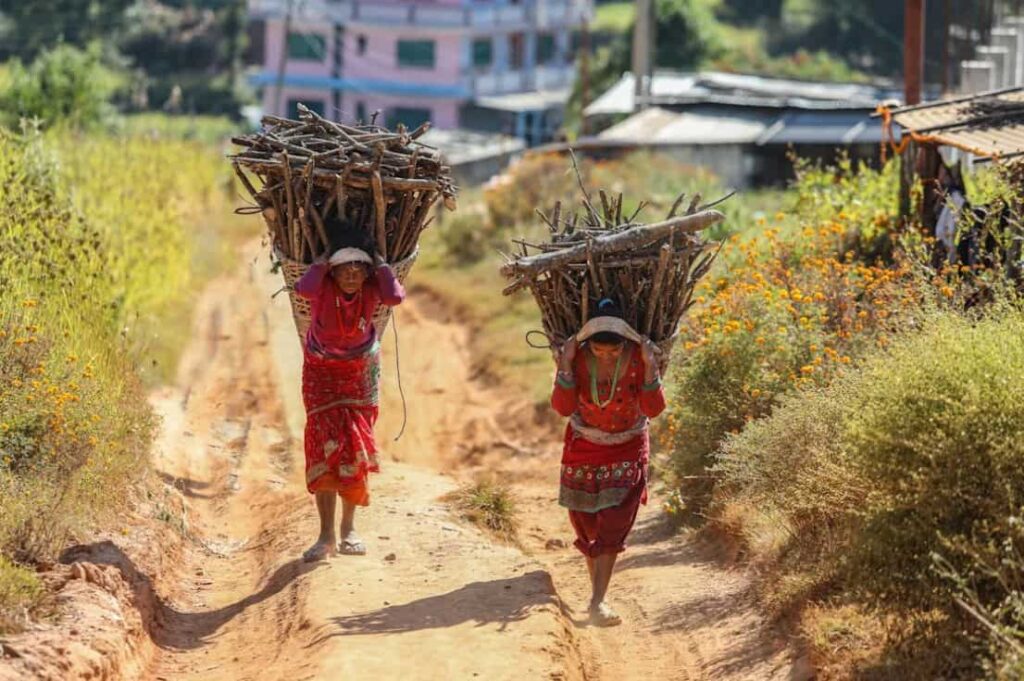
As an agricultural tool, the kukri is hard to beat. Its curved blade makes it excellent for chopping through thick vegetation, whether you’re clearing a path or harvesting crops. I’ve seen farmers use it to cut everything from rice stalks to small tree branches. The weight of the blade, combined with its curve, gives it a natural chopping action that’s surprisingly efficient. It’s like a machete, axe, and pruning knife all rolled into one.
As an everyday utility knife, the kukri is remarkably versatile. I’ve seen people use it for everything from food preparation to woodworking. Its size might seem unwieldy for small tasks, but the blade near the handle is actually quite thin and good for precise cuts. The heavier front portion is great for tasks that require more force, like splitting small logs for firewood. In many Nepalese households, especially in rural areas, the kukri is the go-to tool for a wide range of daily tasks.
Kukri Military Applications
While the kukri’s versatility in everyday life is impressive, its reputation as a formidable weapon in close combat is what often captures people’s imagination. I’ve studied various military blades over the years, and the kukri stands out for its effectiveness in hand-to-hand fighting.
The kukri’s forward-curving blade gives it a natural chopping action that can deliver devastating strikes. In close quarters, this design allows for powerful, cleaving blows with minimal effort. The weight distribution of the blade also means that even a relatively light strike can cause significant damage. It’s not just about brute force, though. The kukri’s design also allows for quick, precise cuts and thrusts when needed.
What’s particularly interesting is how the kukri’s combat effectiveness comes from the same features that make it useful as a tool. The curve that’s so good for chopping wood is equally effective against an opponent. The point, which is useful for detailed work in everyday tasks, can be lethal in combat situations.
When it comes to the Gurkha regiments, the kukri is more than just a weapon – it’s a symbol of their identity and fierce reputation. Every Gurkha soldier carries a kukri as part of their standard equipment. It’s as much a part of their uniform as their rifle or beret. I’ve had the privilege of handling some Gurkha service kukris, and they’re typically robust, no-frills versions of the traditional design, built for durability and functionality.
The kukri’s association with the Gurkhas has cemented its place in military history. There are numerous accounts of Gurkha soldiers using their kukris effectively in various conflicts, from World War I to more recent engagements. These stories have contributed to the almost legendary status of both the Gurkhas and their signature blade.
Modern Adaptations of the Kukri
The kukri’s journey from traditional Nepalese tool to global icon has led to some interesting developments in recent years. I’ve seen a wide range of modern adaptations that put new spins on this classic design.
Contemporary kukri designs often incorporate modern materials while maintaining the blade’s iconic shape. I’ve handled kukris with blades made from high-end steels like D2 or even Damascus, offering improved edge retention and corrosion resistance. Some makers are experimenting with synthetic handle materials like G10 or Micarta, which provide excellent grip in all conditions. These modern materials can make the kukri more durable and easier to maintain, though purists might argue they lack the character of traditional versions.
Damascus Kukri
A particularly noteworthy modern adaptation is the Damascus kukri. The use of Damascus steel, known for its distinctive wavy patterns and superior strength, brings a blend of ancient forging techniques and modern aesthetics to the kukri. These blades are not only visually striking but also offer exceptional durability and edge retention. Collectors and users alike appreciate the unique combination of traditional kukri design with the enhanced performance characteristics of Damascus steel. This makes the Damascus kukri a sought-after piece for both functional use and display.
Among collectors and enthusiasts, the kukri has gained quite a following. I’ve met folks who specialize in collecting historical Gurkha kukris, each with its own story and provenance. Others are drawn to high-end custom kukris, made by skilled bladesmiths who put their own spin on the traditional design. The kukri’s unique shape and rich history make it an appealing choice for blade enthusiasts looking for something different from typical knives or swords.
What’s particularly interesting is the kukri’s adoption in survival and bushcraft circles. Its versatility as a chopping and cutting tool makes it well-suited for outdoor use. I’ve seen kukris marketed specifically as survival tools, often with additional features like saw-back spines or hollow handles for storing small items. In bushcraft, the kukri’s ability to perform the functions of both a knife and a small axe makes it a popular choice for those looking to minimize the number of tools they carry.
Some modern kukris are designed specifically for tactical or military use, with features like serrated edges or non-reflective coatings. While these might not be traditional, they show how the kukri’s design continues to be adapted for new purposes.
Where Can I Get My Own Kukri?
When looking to add a kukri to your collection, you have several options. Traditional kukris can often be found at specialty shops that import directly from Nepal, ensuring authenticity and craftsmanship. For modern versions, many reputable knife makers offer kukris with contemporary materials and designs. Online marketplaces also provide a wide range, but it’s important to buy from trusted sellers to guarantee quality.
Machete Specialists
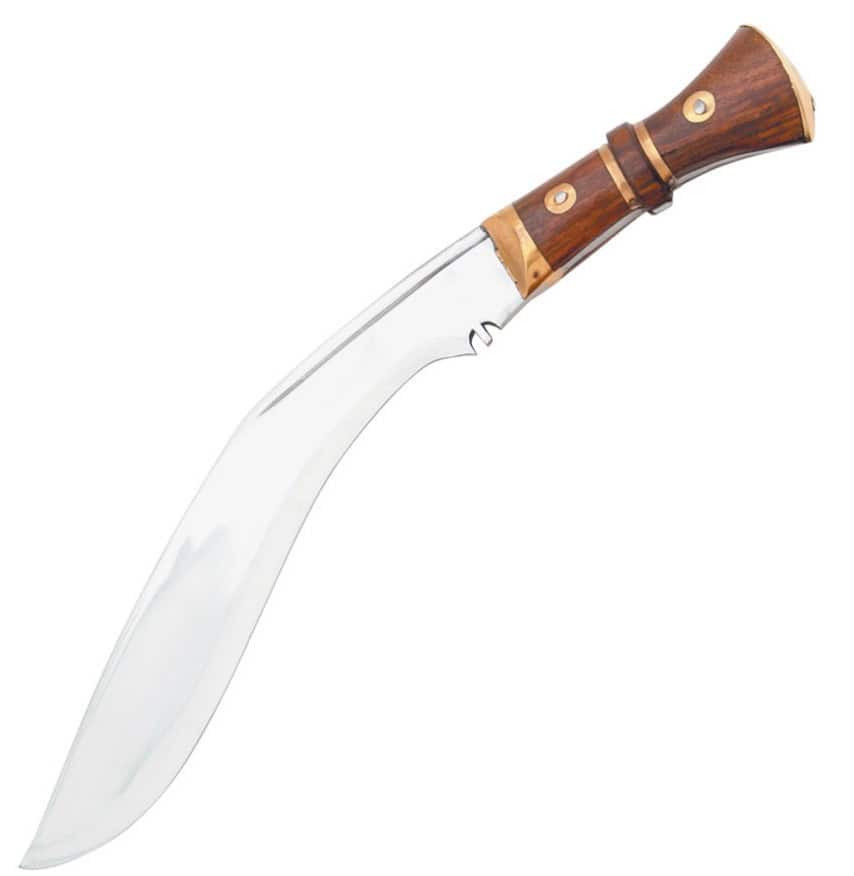
What I Like:
- Wood Handle and Brass Bolster and Pommel: The wood handle with brass bolster and pommel provides a sturdy grip and an attractive finish.
- Stainless Steel Blade: The stainless steel blade is durable and corrosion-resistant, making it ideal for various tasks.
- Heavy Duty Leather Sheath Included: A thick leather sheath is included for safe storage and easy transport.
The Khukuri House
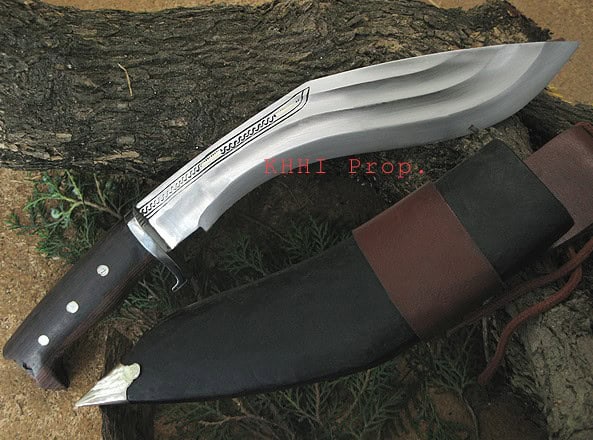
What I Like:
- Blade material and sharpness: The blade is made from durable 5160 steel and is very sharp, suitable for combat and heavy-duty use.
- Handle material and finishing: The handle is crafted from polished rosewood, providing a comfortable and sturdy grip.
- Sheath: The blade comes with a water buffalo hide scabbard, adding to its durability and authentic look.
Spartan Blades
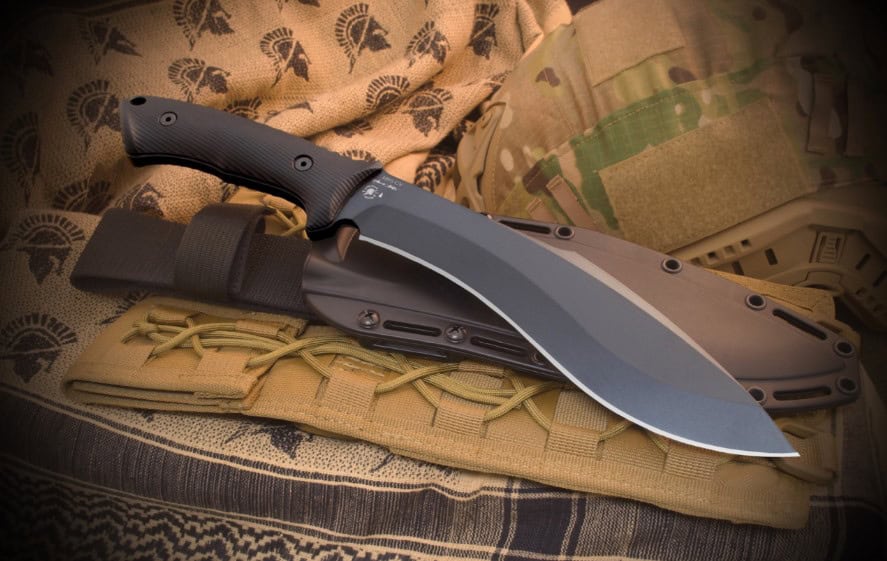
What I Like:
- Design by William W. Harsey Jr.: The Spartan-Harsey Kukri is designed by the legendary knife maker, adding prestige and expert craftsmanship.
- Durable Blade: Made from 1095 Cro-Van steel with a hardness of 56-58 HRC, the blade offers durability and excellent edge retention.
- Comfortable Handle: The contoured, black injection molded handle provides a secure and comfortable grip for extended use.
BladeHQ
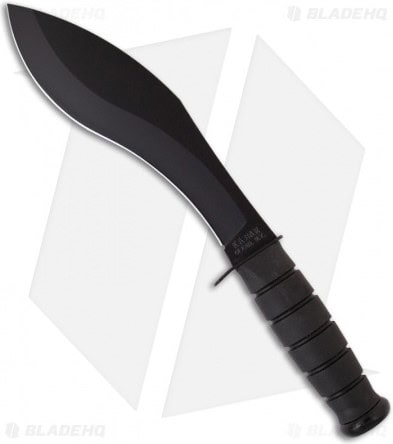
What I Like:
- Blade Material: The blade is made of 1095 high carbon steel, known for its durability and edge retention.
- Blade Style: It features a kukri blade style, offering excellent chopping power and versatility.
- Handle Material: The handle is made of Kraton, providing a secure and comfortable grip.
Etsy – PocketBlades
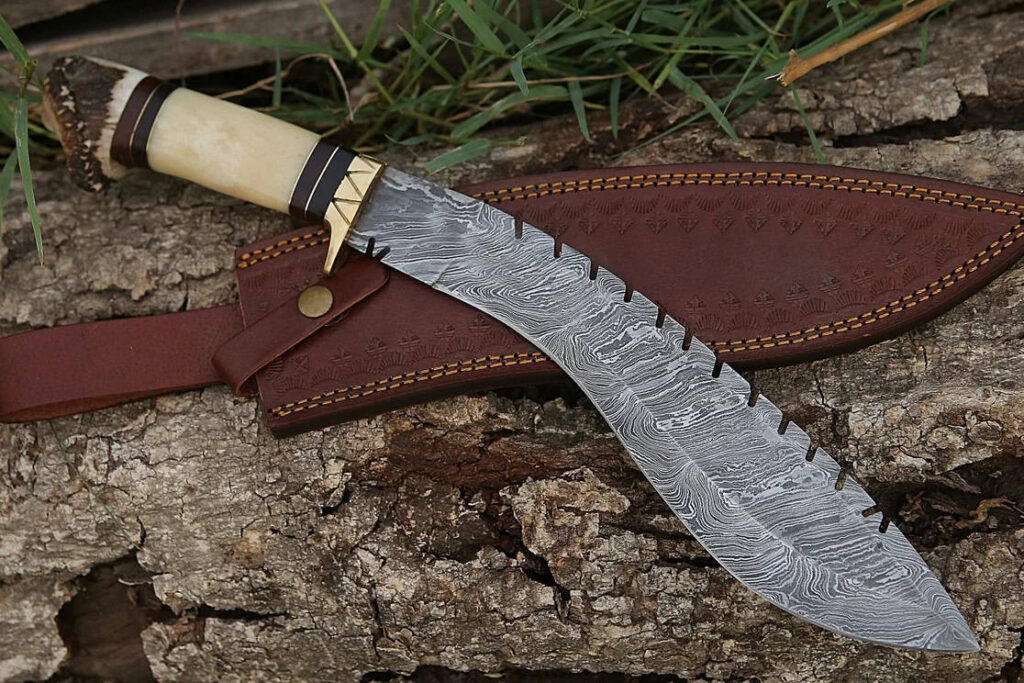
Etsy – CustomDamascusByJose
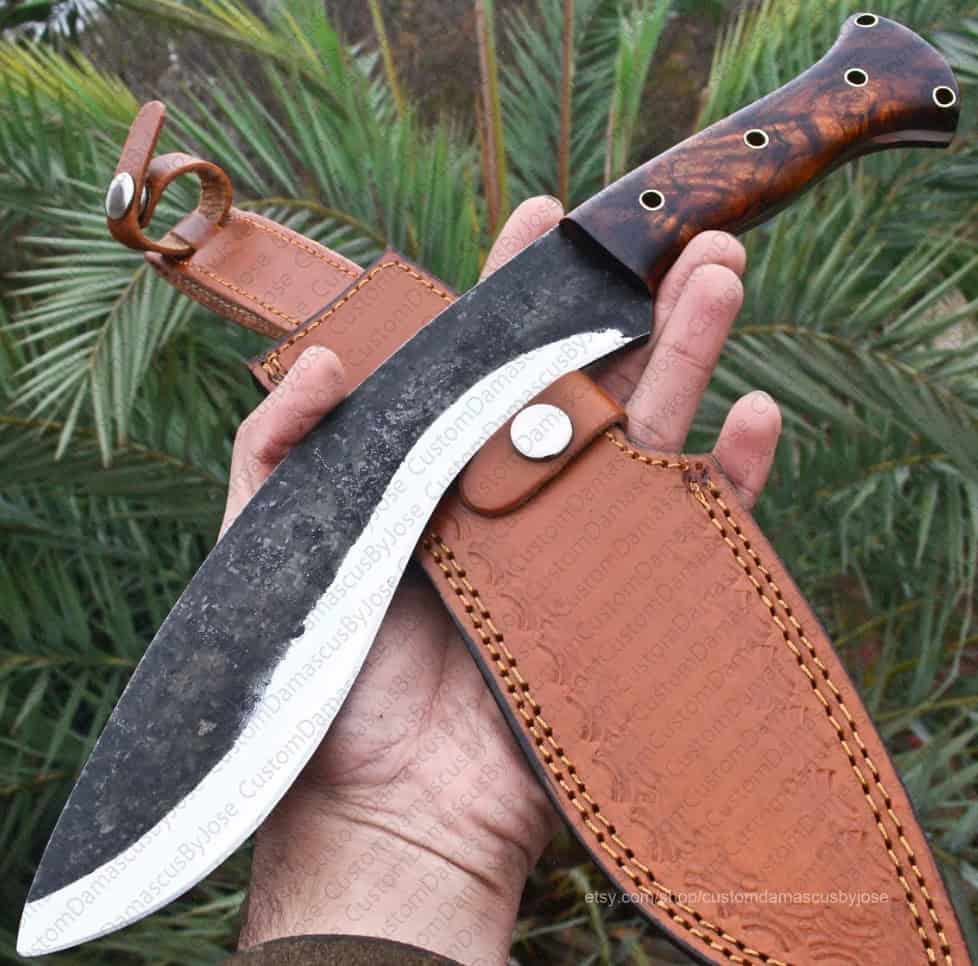
Etsy – RagnaroksEnd
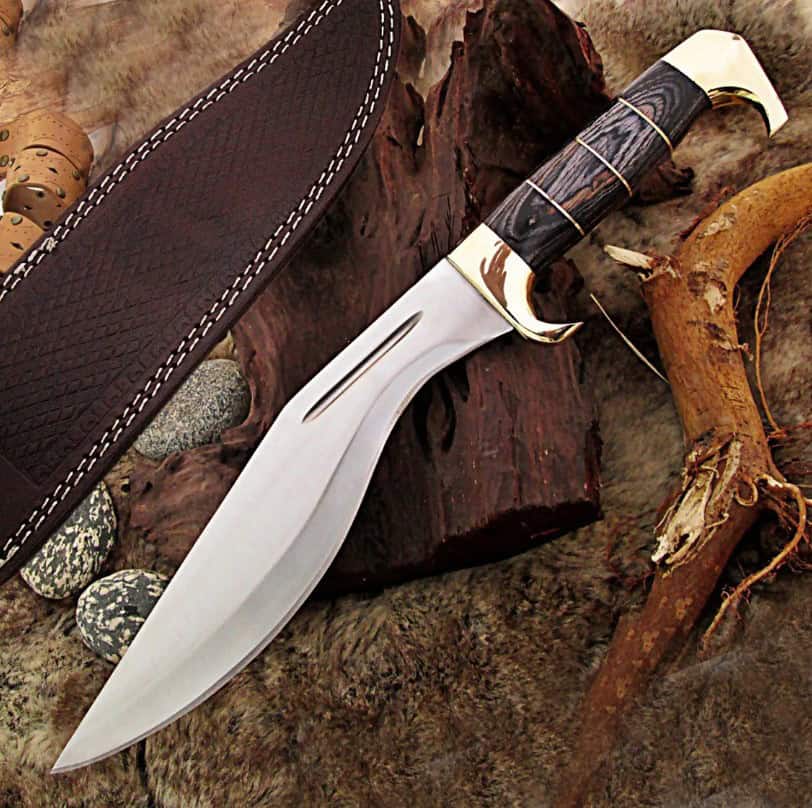
Final Thoughts
The kukri is a blade that consistently impresses me. Its unique forward curve, deep historical roots, and incredible versatility make it a standout in any collection. Originating from the hills of Nepal, it has evolved from a traditional agricultural tool to a renowned weapon, especially in the hands of the legendary Gurkha soldiers.
Handling a kukri reveals its thoughtful design—perfectly balanced for chopping and precise enough for finer tasks. The curve isn’t just for show; it effectively concentrates force, making it incredibly efficient. The craftsmanship, whether in traditional models or modern adaptations, showcases a blend of durability and functionality.
